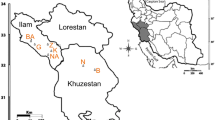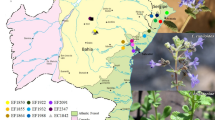Abstract
Descurainia sophia is a valuable medicinal plant in family of Brassicaceae. To determine the range of diversity amongst D. sophia in Iran, 32 naturally distributed plants belonging to six natural populations of the Iranian plateau were investigated by inter-simple sequence repeat (ISSR) markers. The average percentage of polymorphism produced by 12 ISSR primers was 86 %. The PIC values for primers ranged from 0.22 to 0.40 and Rp values ranged between 6.5 and 19.9. The relative genetic diversity of the populations was not high (Gst =0.32). However, the value of gene flow revealed by the ISSR marker was high (Nm = 1.03). UPGMA clustering method based on Jaccard similarity coefficient grouped the genotypes into two major clusters. Graph results from Neighbor-Net Network generated after a 1000 bootstrap test using Jaccard coefficient, and STRUCTURE analysis confirmed the UPGMA clustering. The first three PCAs represented 57.31 % of the total variation. The high levels of genetic diversity were observed within populations, which is useful in breeding and conservation programs. ISSR is found to be an eligible marker to study genetic diversity of D. sophia.







Similar content being viewed by others
References
Alberto FJ, Aitken SN, Alía R, González-Martínez SC, Hänninen H, Kremer A, Lefèvre F, Lenormand T, Yeaman S, Whetten R, Savolainen O (2013) Potential for evolutionary responses to climate change-evidence from tree populations. Glob Chang Biol 19:1645–1661
Baskin CC, Milberg P, Andersson L, Baskin JM (2004) Germination ecology of seeds of the annual weeds capsella bursa-pastoris and Descurainia sophia originating from high northern latitudes. Weed Res 44:60–68
Bakker EG, Toomajian C, Kreitman M, Bergelson J (2006) A genome-wide survey of R gene polymorphisms in Arabidopsis. Plant Cell 18:1803–1818
Bekker NP, Ulchenko NT, Glushenkova AI (2005) Lipids from Descurainia sophia seeds. Chem Nat Compd 41:346–347
Bhattacharyya P, Kumaria S (2015) Molecular characterization of Dendrobium nobile lindl., an endangered medicinal orchid, based on randomly amplified polymorphic DNA. Plant Syst Evol 301:201–210
Blackshaw RE, Molnar LJ, Larney FJ (2005) Fertilizer, manure and compost effects on weed growth and competition with winter wheat in western Canada. Crop Prot 24:971–980
Chawla HS (2003) Introduction to plant biotechnology. Oxford and IBH pub, 2nd edn. Delhi, p. 538
Doyle JJ, Doyle JL (1987) A rapid DNA isolation procedure for small quantities of fresh tissue. Phytochem Bull 19:11–15
Duke JA, Ayensu ES (1985) Medicinal plants of China. Reference Pub Inc, ISBN 0917256204:705
Excoffier L, Lischer HEL (2010) Arlequin suite ver 3.5: a new series of programs to perform genetics analyses under Linux and windows. Mol Ecol Resour 10:564–567
Excoffier L, Smouse P, Quattro J (1992) Analysis of molecular variance inferred for metric distances among DNA haplotypes: application to human mitochondrial DNA restriction data. Genetics 131:479–491
Govindaraj M, Vetriventhan M, Srinivasan M (2015) Importance of genetic diversity assessment in crop plants and its recent advances: an overview of its analytical perspectives. Genet Res Int 2015:431487. doi:10.1155/2015/431487
Gruzdienė D, Bagdonaitė K (2003) Traditional and nontraditional oil plants grown in Lithuania: chemical characteristics and stability of edible oil. In: Šeškevičienė J, Mikulionienė S, Klimas E, Jeroch H (eds) The IIth Lithuania-Germany oily plants day. Lithuanian Academy of Veterinary, Kaunas, pp. 31–37[In Lithuanian]
Hernandez Plaza E, Kozak M, Navarrete L, Gonzalez-Andujar JL (2011) Tillage system did not affect weed diversity in a 23-year experiment in Mediterranean dryland. Agric Ecosyst Environ 140:102–105
Hubisz MJ, Falush D, Stephens M, Pritchard JK (2009) Inferring weak population structure with the assistance of sample group information. Mol Ecol Resour 9:1322–1332
Huson DH, Bryant D (2006) Application of phylogenetic networks in evolutionary studies. Mol Biol Evol 23(2):254–267
Jaccard P (1908) Nouvelles recherches Sur la distribution florale. Bull Soc Vaud Sci Nat 44:223–270
Jorgensen S, Mauricio R (2004) Neutral genetic variation among wild north American populations of the weedy plant Arabidopsis thaliana is not geographically structured. Mol Ecol 13:3403–3413
Joshi K, Chavan P, Warude D, Patwardhan B (2004) Molecular markers in herbal drug technology. Curr Sci 87(2):159–165
Kalia RK, Rai MK, Kalia S, Singh R, Dhawan AK (2011) Microsatellite markers: an overview of the recent progress in plants. Euphytica 177:309–334
Khan M, Wang N (2012) Descurainia sophia (L.): a weed with multiple medicinal uses. Punjab Univ J Zool 27(1):45–51
Khezri SH (2001) Culture of herbal plants. Shahab Khezri Pub, Sanandaj. ISBN:9640622672, pp 572 [In Persian]
Khodarahmi E, Asghari GH, Hassanzadeh F, Mirian M, Khodarahmi GA (2015) Cytotoxic evaluation of volatile oil from Descurainia sophia seeds on MCF-7 and HeLa cell lines. Res Pharm Sci 10(2):169–176
Kisha TJ, Johnson RC (2012) Technological innovations in major world oil crops, chapter 6: safflower, SK Gupta (ed), Volume 1, Chapter 6: http://www.springer.com/us/book/9781461403555#
Leimu R, Mutikainen PIA, Koricheva J, Fischer M (2006) How general are positive relationships between plant population size, fitness and genetic variation? J Ecol 94:942–952
Li J, Liu X, Dong F, Xu J, Li Y, Chen W, Zheng YI (2011) Potential allelopathic effects of volatile oils from Descurainia sophia (L.) Webb ex prantl on wheat. Biochem Syst Ecol 39:56–63
Li J, Liu X, Dong F, Xu J, Zheng Y, Shan W (2010) Determination of the volatile composition in essential oil of Descurainia sophia (L.) Webb ex prantl (flixweed) by gas chromatography/mass spectrometry (GC/MS). Molecules 15:233–240
Liu G, Liu L, Gong Y, Wang Y, Yu F, Shen H, Gui W (2007a) Seed genetic purity testing of F1 hybrid cabbage (Brassica oleracea var.capitata) with molecular marker analysis. Seed Sci Technol 35:476–485
Liu J, Shi S, Chang E, Yang W, Jiang Z (2013) Genetic diversity of the critically endangered Thuja sutchuenensis revealed by ISSR markers and the implications for conservation. Int J Mol Sci 14:14860–14871
Liu L, Zhu X, Gong Y, Song X, Wang Y, Zhao L, Wang L (2007b) Genetic diversity analysis of radish germplasm with RAPD, AFLP and SRAP markers. Acta Horticult 760:125–130
Mantel N (1967) The detection of disease clustering and a generalized regression approach. Cancer Res 27:209–220
McDermott JM, McDonald BA (1993) Gene flow in plant pathosystems. Annu Rev Phytopathol 31:353–373
Mitich LW (1996) Flixweed (Descurainia sophia). Weed Technol 10:974–977
Mohamed NH, Mahrous AE (2009) Chemical constituents of Descurainia sophia L. and its biological activity. Rec Nat Prod 3(1):58–67
Mohammadi SA, Prasanna BM (2003) Analysis of genetic diversity in crop plants-salient statistical tools and considerations. Crop Sci 43:1235–1248
Mokhtassi-Bidgoli A, Agha Alikhani M, Nassiri-Mahallati M, Zand E, Gonzalez-Andujar JL, Azari A (2013) Agronomic performance, seed quality and nitrogen uptake of Descurainia sophia in response to different nitrogen rates and water regimes. Ind Crop Prod 44:583–592
Mosaddegh M, Naghibi F, Moazzeni H, Pirani A, Esmaeili S (2012) Ethnobotanical survey of herbal remedies traditionally used in kohghiluyeh va Boyer Ahmad province of Iran. J Ethnopharmacol 141(1):80–95
Maršalkienė N, Sliesaravičius A, Karpavičienė B, Dastikaitė A (2009) Oil content and fatty acids composition of seeds of some Lithuanian wild crucifer species. Agron Res 7(II):654–661
Pasalar M, Bagheri Lankarani K, Mehrabani D, Tolide-i HR, Naseri M (2013) The effect of Descurainia sophia and Prunus domestica in prevention of constipation among Iranian hajj pilgrims, Saudi Arabia. Res J Pharm Biol Chem Sci 4(2):1195–1204
Peakall R, Smouse PE (2006) GENALEX 6: genetic analysis in excel. Population genetic software for teaching and research. Mol Ecol Notes 6:288–295
Peng L, Yi Y, Fu-li G, Ze-qü L (1997) A preliminary study on the introduction of Descurainia sophia, an oil plant species for industrial uses. Acta Bot Sin 39:477–479
Prevost A, Wilkinsin MJ (1999) A new system of comparing PCR primers applied to ISSR fingerprinting of potato cultivars. Theor Appl Genet 98:107–112
Reddy M, Pradeep Sarla N, Siddiq EA (2002) Inter simple sequence repeat (ISSR) polymorphism and its application in plant breeding. Euphytica 128:9–17
Roldán-Ruiz I, Dendauw J, Bockstaele EV, Depicker A, Loose MD (2000) AFLP markers reveal high polymorphic rates in ryegrasses (Lolium Spp). Mol Breed 6:125–134
Rohlf FJ (1992) NTSYS-pc. Numerical taxonomy and multivariate analysis system. Setauket, NY, Exeter Software
Rohlf FJ, Sokal RR (1981) Comparing numerical taxonomic studies. Syst Zool 30:459–490
Sehgal D, Raina SN (2008) DNA markers and germplasm resource diagnostics: new perspectives in crop improvement and conservation strategies. In: Arya ID, Arya S (eds) Utilization of biotechnology in plant sciences. Rastogi Press, Meerut, India, pp. 39–54
Singh P, Sharma H, Srivastava N, Bhagyawant S (2014) Analysis of genetic diversity among wild and cultivated chickpea genotypes employing ISSR and RAPD markers. Am J Plant Sci 5:676–682
Stenoien HK, Fenster CB, Tonteri A, Savolainen O (2005) Genetic variability in natural populations of Arabidopsis thaliana in northern Europe. Mol Ecol 14:137–148
Sun K, Li X, Liu JM, Wang JH, Li W, Sha Y (2005) A novel Sulphur glycoside from the seeds of Descurainia sophia (L.). J Asian Nat Prod Res 7:853–856
Rivers MC, Brummitt NA, Nic Lughadha E, Meagher TR (2014) Do species conservation assessments capture genetic diversity? Glob Ecol Conserv 2:81–87
Tkachuk R, Mellish VJ (1977) Amino acid and proximate analysis of weed seeds. Can J Plant Sci 57:243–249
Varsheny RK, Graner A, Sorrells ME (2005) Genic microsatellite markers in plants: features and applications. Trends Biotechnol 23:48–55
Wang S, Yang W, Shen H (2011) Genetic diversity in Apium graveolens and related species revealed by SRAP and SSR markers. Sci Hortic 129:1–8
Yeh FC, Boyle TJB (1997) Population genetic analysis of codominant and dominant markers and quantitative traits. Belg J Bot 129:157
Zhang ZP (2003) Development of chemical weed control and integrated weed management in China. Weed Biol Manag 3(4):197–203
Acknowledgments
This work was financially supported by a research grant (No. 90322651) from Bu Ali-Sina University, Hamedan, Iran.
Author information
Authors and Affiliations
Corresponding author
Ethics declarations
Author contribution
All authors made substantial contributions to the work presented in this paper.
Conflict of interest
The authors declare that they have no conflict of interest.
Rights and permissions
About this article
Cite this article
Saki, S., Bagheri, H., Deljou, A. et al. Evaluation of genetic diversity amongst Descurainia sophia L. genotypes by inter-simple sequence repeat (ISSR) marker. Physiol Mol Biol Plants 22, 97–105 (2016). https://doi.org/10.1007/s12298-015-0330-2
Received:
Accepted:
Published:
Issue Date:
DOI: https://doi.org/10.1007/s12298-015-0330-2




